2012 年山东青岛科技大学英语考研真题
PART I. READING COMPREHENSION (38%)
Directions: Read the passages given below and choose the best answer to the questions
attached to each of them.
Passage One
Questions 1-3 are based on the following passage.
If you like the idea of staying with a family, living in house might be the answer.
Good landladies---those who are superb cooks and launders, are figures as popular
in fiction as the bad ones who terrorize their guest and overcharge them at the
slightest opportunity. The truth is probably somewhere between the two extremes.
If you are lucky, the food will be adequate, some of your laundry may be done for
you and you will have a reasonable amount of comfort and companionship .For the less
fortune ,house rules may restrict the freedom to invite friends to visit, and shared
cooking and bathroom facilities can be frustrating and row-provoking if tidy
and untidy guest are living under the same roof.
The same disadvantages can apply to flat sharing, with the added difficulties that
arise from deciding who pays for what, and in what proportion. One person may spend
hours on the phone, while another rarely makes calls. If you want privacy with guest,
how do you persuade the others to go out; how do you persuade them to leave you in
peace, especially if you are student and want to study?
Conversely, flat sharing can be very cheap, there will always be someone to talk
to and go out with, and the chores ,in theory, can be shared.
1.According to the passage ,landladies are ________
A.usually strict.
B. always mean.
C. adequately competent.
D. very popular with their guest.
2.What is the additional disadvantage of flat sharing ?
A. Problems of sharing and paying.
B. Differences in living habits.
C. Shared cooking and bathroom facilities.
D. Restriction to invite friends to visit.
3.What is NOT mentioned as a benefit of flat sharing?
A. Rent is affordable
B. There is companionship.
C. Housework.
D. There is peace and quiet.
Passage Two
Questions 4-8 are based on the following passage.
I am afraid to sleep. I have been afraid to sleep for the last few weeks. I am so
tired that,
�
finally, I do sleep, but only for a few minutes. It is not a bad dream that wakes
me; it is the reality I took with me into sleep . I try to think of something else.
Immediately the woman in the marketplace comes into my mind.
I was on my way to dinner last night when I saw her . She was selling skirts. She
moved with the same ease and loveliness I often saw in the women of Laos. Her long
black hair was as shiny as the black silk of the skirts she was selling. In her hair,
she wore three silk ribbons, blue, green, and white. They reminded me of my childhood
and how my girlfriends and I used to spend hours braiding ribbons into our hair.
I don’t know the word for “ribbons”, so I put my hand to my own hair and , with
three fingers against my head , I looked at her ribbons and said “Beautiful.” She
lowered her eyes and said nothing. I wasn’t sure if she understood me (I don’t
speak Laotian very well).
I looked back down at the skirts. They add designs in them: squares and triangles
and circles of pink and green silk. They were very pretty. I decided to buy one of
those skirts, and I began to bargain with her over the price. It is the custom to
bargain in Asia. In Laos bargaining is done in soft voices and easy moves with the
sort of quiet peacefulness. She smiled, more with her eyes than with her lips. She
was pleased by the few words I was able to say in her language, although they were
mostly numbers, and she saw that I understood something about the soft playfulness
of bargaining. We shook our heads in disagreement over the price; then, immediately,
we made another offer and then another shake of the head. She was
so pleased that unexpectedly, she accepted the last offer I made. But it was too
soon. The price was too low. She was being too generous and wouldn’t make enough
money. I moved quickly and picked up two more skirts and paid for all three at the
price set; that way I was able to pay her three times as much before she had a chance
to lower the price for the larger purchase. She smiled openly then, and, for the
first time in months, my spirit lifted. I almost felt happy.
The feeling stayed with me while she wrapped the skirts in a newspaper and handed
them to me. When I left, though, the feeling left, too. It was as though it stayed
behind in marketplace. I left tears in my throat. I wanted to cry. I didn’t , of
course. I have learned to defend myself against what is hard; without knowing it,
I have also
learned to defend myself against what is soft and what should be easy.
I get up, light a candle and want to look at the skirts. They are still in the newspaper
that the
woman wrapped them in. I remove the paper, and raise the skirts up to look at them
again before
I pack them. Something falls to floor. I reach down and feel something cool in my
hand. I move
close to the candlelight to see what I have. There are five long silk ribbons in
my hand, all
different colors. The woman in the marketplace! She has given these ribbons to me!
There is no defense against a generous spirit, and this time I cry, and very hard,
as if I could
�
make up for all the months that I didn’t cry.
4. Which of the following in NOT correct?
A. The writer was not used to bargaining.
B. People in Asia always bargain when buying things.
C. Bargaining in Laos was quiet and peaceful.
D. The writer was ready to bargain with the woman.
5. The writer assumed that the woman accepted the last offer mainly because woman
A. thought that the last offer was reasonable.
B. thought she could still make much money.
C. was glad that the writer knew their way of bargaining.
D. was tired of bargaining with the writer any more.
6. Why did the writer finally decide to buy three skirts?
A. The skirts were cheap and pretty.
B. She liked the patterns on the skirts.
C. She wanted to do something as compensation.
D. She was fed up with further bargaining with the woman.
7. When did the writer left the marketplace, she wanted to cry, but did not because
A. she had learned to stay cool and unfeeling.
B. she was afraid of crying in public.
C. she had learned to face difficulties bravely.
D. she had to show in public that she was strong.
8. Why did the writer cry eventually when she looked at the skirts again?
A. she suddenly felt very sad.
B. she liked the ribbons so much.
C. she was overcome by emotion.
D. she felt sorry for the woman.
Passage Three
Questions 9-14 are based on the following passage.
The kids are hanging out. I pass small bands of students, in my way to work these
morings.
They have become a familiar part of the summer landscape.
These kids are not old enough for jobs. Nor are they rich enough for camp. They are
school
children without school. The calendar called the school year ran out on them a few
weeks ago.
Once supervised by teachers and principals, they now appear to be “self care”.
Passing them is like passing through a time zone. For much of our history, after
all,
Americans arranged the school year around the needs of work and family. In
19th-century cities,
schools were open seven or eight hours a day, 11 months a year. In rural America,
the year was
arranged around the growing season. Now, only 3 percent of families follow the
agricultural
�
model, but nearly all schools are scheduled as if our children went home early to
milk the cows
and took months off to work the crops. Now, three-quarters of the mothers of
school-age
children work, but the calendar is written as if they were home waiting for the school
bus.
The six-hour day, the 180-day school year is regarded as something holy. But when
parents
work an eight-hour day and a 240-day year, it means something different. It means
that many
kids go home to empty houses. It means that, in the summer, they hang out.
“We have a huge mismatch between the school calendar and realities of family life,”
says
Dr. Ernest Boyer, head of the Carnegie Foundation for the Advancement of Teaching.
Dr. Boyer is one of many who believe that a radical revision of the school calendar
is
inevitable."School, whether we like it or not, is educational. It always has been.”
His is not popular idea. School are routinely burdened with the job of solving all
our social
problems. Can they be asked to meet the needs of our work and family lives?
It may be easier to promote a linger school year on its educational merits and, indeed,
the
educational case is compelling. Despite the complaints and studies about our kids’
lack of
learning, the United State still has a shorter school year than any industrial nation.
In most of
Europe, the school year is 220 days. In Japan, it is 240 days long. While classroom
time alone
doesn’t produce a well-educated child, learning takes time and more learning takes
more time.
The long summers of forgetting take a toll.
The opposition to a longer school year comes from families that want to and can
provide
other experiences for their children. It comes from teachers. It comes from tradition.
And surely
from kids. But the most important part of the conflict has been over the money.
9. Which of the following is an opinion of the author’s?
A."The kids are hanging out.”
B."They are school children without school.”
C."These kids are not old enough for jobs.”
D. “The calendar called the school year ran out on them a few weeks ago.”
10. The current American school calendar was developed in the 19th century according
to
A. the growing season on nation’s form.
�
B. the labor demands of the industrial age.
C. teachers’ demands for more vacation time.
D. parents’ demands for other experiences for their kids.
11. The author thinks that the current school calendar
A. is still valid.
B. is out of date.
C. can not be revised.
D. can not be defended.
12. Why was Dr. Boy’s idea unpopular?
A. He argues for the role of school in solving social problems.
B. He supports the current school calendar.
C. He thinks that school year and family life should be considered separately.
D. He strongly believes in the educational role of school.
13. “The long summers of forgetting take a toll ”in the last paragraph but one
means that
A. long summer vacation slows down the progress go learning.
B. long summer vacation has been abandoned in Europe.
C. long summers result in less learning time.
D. long summers are a result of tradition.
14. The main purpose of the passage is
A. to describe how American children spend their summer.
B. to explain the needs of the modern working families.
C. to discuss the problems of the current school calendar.
D. to persuade parents to stay at home to look after their kids.
Passage Four
Questions 15-19 are based on the following passage.
Women's minds work differently from men's. At least, that is what most men are
convinced
of. Psychologists view the subject either as a matter of frustration or a joke. Now
the biologists
have moved into this minefield, and some of them have found that there are real
differences
between the brains of men and women. But being different, they point out hurriedly,
is not the
same as being better or worse.
There is, however, a definite structural variation between the male and female brain.
The
difference is in a part of the brain that is used in the most complex inte11ectual
processes-the
link between the two halves of the brain.
The two halves are linked by trunkline of between 200 and 300 million nerves, the
Corpus
callosum. Scientists have found quite recently that the Corpus callosum in women
is always
�
larger and probably richer in nerve fibers than it is in men. This is the first time
that a structural
difference has been found between the brains of women and men and it must have some
significance. The question is "What?", and, if this difference exists, are there
others? Research
shows that present-day women think differently and behave differently from men. Are
some of
these differences biological and inborn, a result of evolution? We tend to think
that is the
influence of society that produces these differences. But could we be wrong?
Research showed that these two halves of the brain had different functions, and that
the
Corpus callosum enabled them to work together. For most people, the left half is
used for word -
handling, analytical and logical activities; the right half works on pictures,
patterns and forms.
We need both halves working together. And the better the connections, the more
harmoniously
the two halves work. And, according to research findings, women have the better
connections.
But it isn't all that easy to explain the actual differences between skills of men
and women
on this basis. In schools throughout the world girls tend to be better than boys
at“language
subjects”and boys better at maths and physics. If these differences correspond with
the
differences in the hemispheric trunkline, there is an unalterable distinction
between the sexes.
We shan't know for a while, partly because we don't know of any precise relationship
between abilities in school subjects and the functioning of the two halves of the
brain ,and we
cannot understand how the two halves interact via the corpus callosum. But this
striking
difference must have some effect and, because the difference is in the parts of the
brain involved
in intellect, we should be looking for differences in intellectual processing.
15. Which of the fo11owing statements is CORRECT?
A. Biologists are conducting research where psychologists have given up.
B. Brain differences point to superiority of one sex over the other.
C. Results of scientific research fail to support popular belief.
D. The structural difference in the brain between the sexes has long been known.
16. According to the passage it is commonly believed that brain differences are
caused by
________ factors.
�
A. biological
B .psychological
C. physical
D .social
17."these differences" in paragraph 5 refer to those in
A. skills of men and women.
B. school subjects.
C. the brain structure of men and women.
D. activities carried out by the brain.
18. At the end of the passage the author proposes more work on
A. the brain structure as a whole.
B. the functioning of part of the brain.
C. the distinction between the sexes.
D. the effects of the corpus callosum.
19. What is the main purpose of the passage?
A. To outline the research findings on the brain structure.
B. To explain the link between sex and brain structure.
C. To discuss the various factors that cause brain differences.
D. To suggest new areas in brain research.
PART II CLOZE (15%)
Directions: Choose a proper word from the list to fill in each blank in the following
passage.
Change the form of the word if necessary.
base create evoke suffice hand
deeply poorly dispose degree depend
vary religious present movement endeavor
Everything that the human race has done and thought is concerned with the
satisfaction of
(1)__________ felt needs and the assuagement of pain. One has to deep this constantly
in mind
if one wishes to understand spiritual (2)___________ and their development. Feeling
and
longing are the motive force behind all human (3)___________ and human creation,
in however
exalted a guise the latter may (4)__________ themselves to us. Now what are the
feelings and
needs that have led men to (5)__________ thought and belief in the widest sense of
the words?
A little consideration will (6)___________ to show us that the most (7)___________
emotions
preside over the birth of religious thought and experience. With primitive man it
is above all fear
that (8)__________ religious notions—fear of hunger, wild beasts, sickness, death.
Since at this
�
stage of existence understanding of causal connections is usually (9)__________
developed, the
human mind (10)__________ illusory beings more or less analogous to itself on whose
wills and
actions these fearful happenings (11)___________. Thus one tries to secure the favor
of these
beings by carrying out actions and offering sacrifices which, according to the
tradition
(12)_________ down from generation to generation, propitiate them or make them well
(13)___________ toward a mortal. In this sense I am speaking of a religion of fear.
This, though
not created, is in an important (14)___________ stabilized by the formation of a
special priestly
caste which sets itself up as a mediator the people and the beings they fear, and
erects a
hegemony on this (15)________.
PART III TRANSLATION (15%)
(I)Translate the following into Chinese:(10%)
1. This discovery suggests that life is probably a pretty ordinary phenomenon that
occurs any
place you give it half a chance.
2. But I find it helpful to consider what might have happened in my own marriage
if a copy of
me had been made to overcome infertility.
3. Forty years after the Wright Brothers’ first flight, by contrast, commercial
air travel was a
dauntingly expensive but widespread and growing industry.
4. The promissory notes of well-known individuals and bills of exchange drawn on
English
merchants readily exchanged hands for several months.
5.When the demand becomes immoderate, consumption of drugs increases and the
incidence of
adverse effects and waste follows suit.
(II)Translate the following into English (5%)
随着 1997 年许多东亚国家经济中出现的戏剧性的货币贬值,这些国家遭受了急剧而且
徘徊不去的经济衰退。这种结果违反了贬值使国内生产的商品更便宜而应当提高产量
的观 点。
PART IV PARAPHRASE (10%)
Directions: Explain the following sentences in English in your own words.
1. International investors have become more sensitive to differing national tax
rates as their
investment options have increased.
2. SARS may have dominated the headlines last week, but it wasn’t the only weird
disease on
�
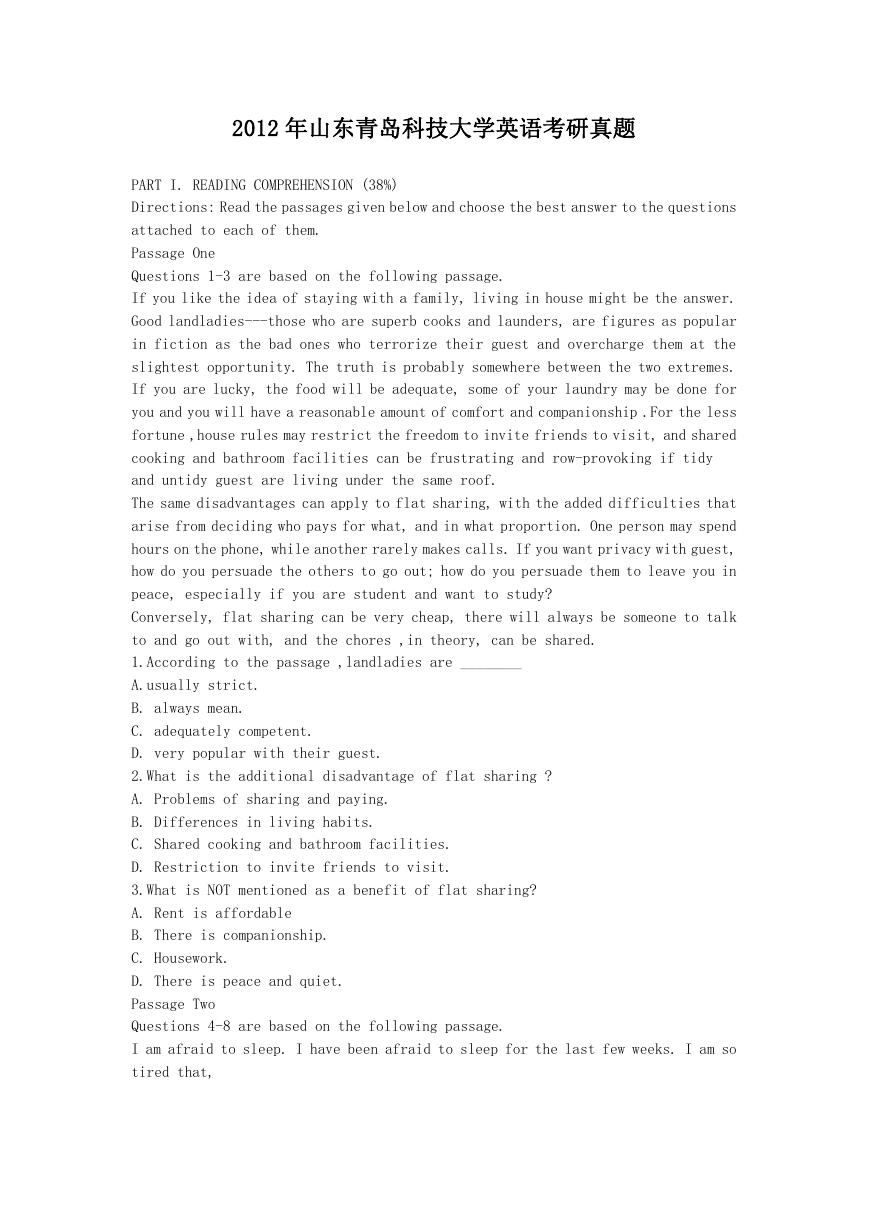
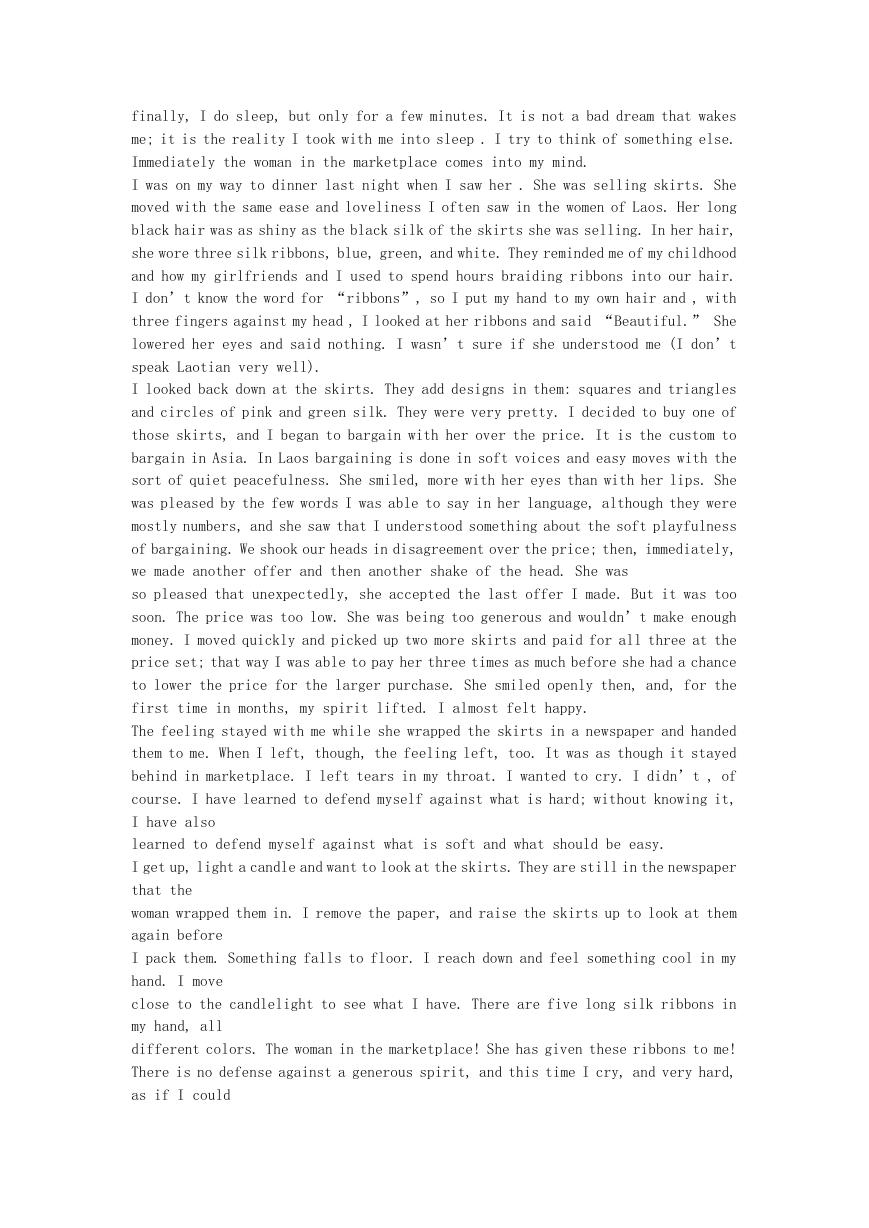
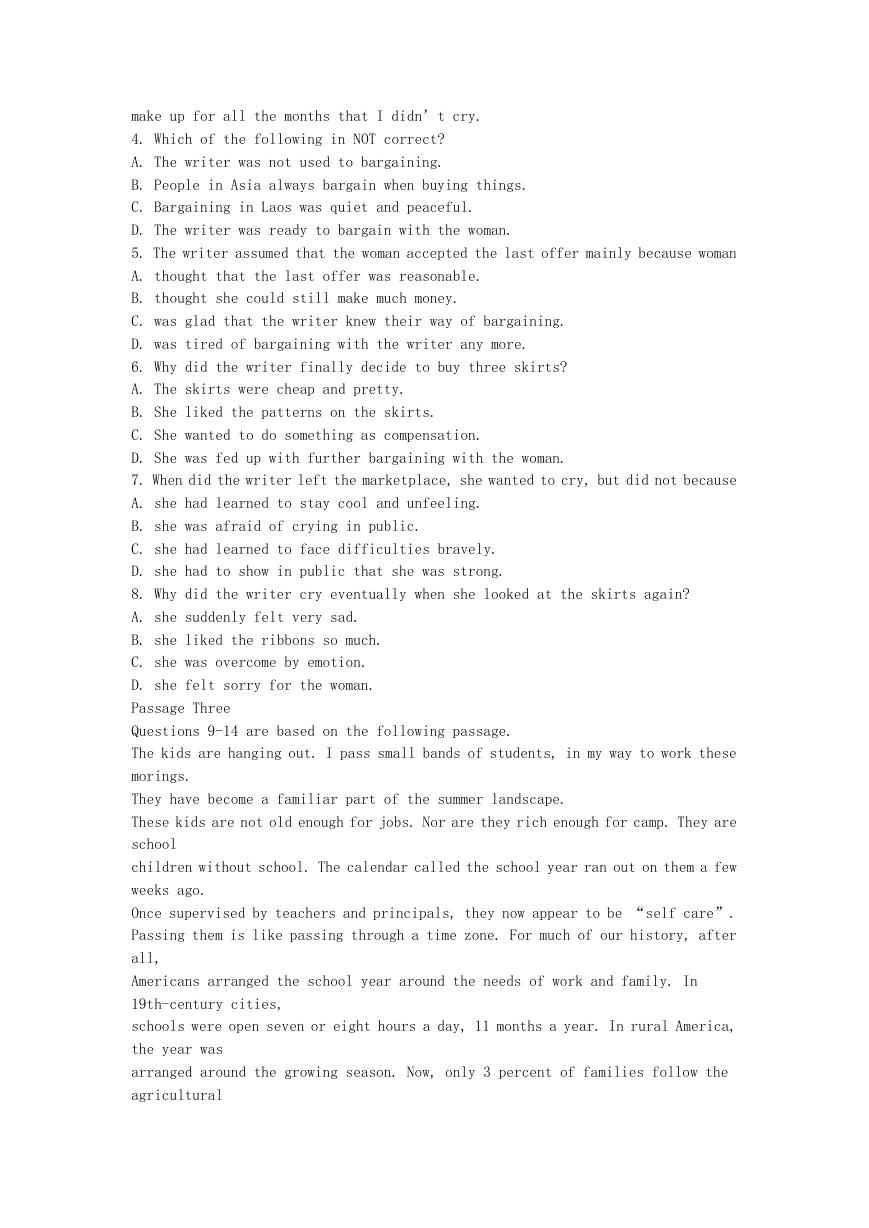
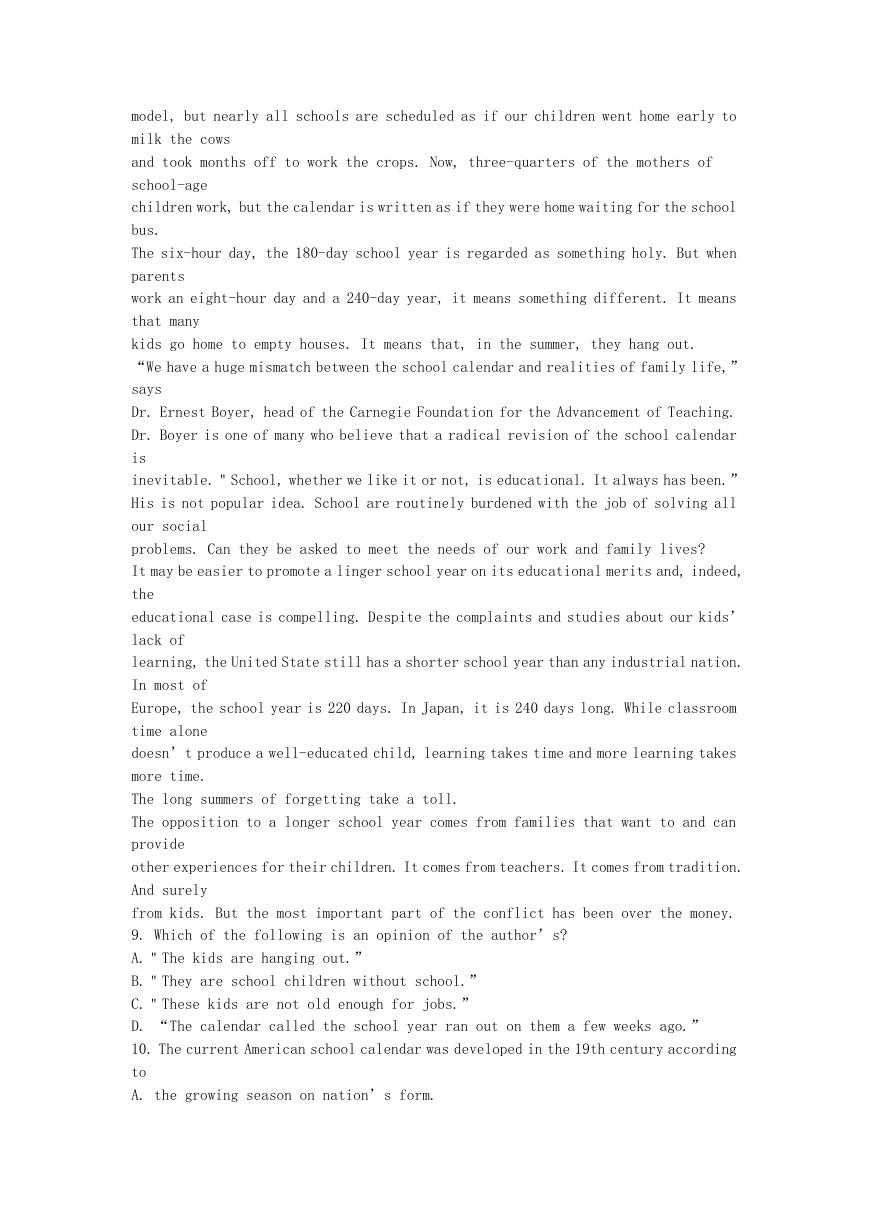
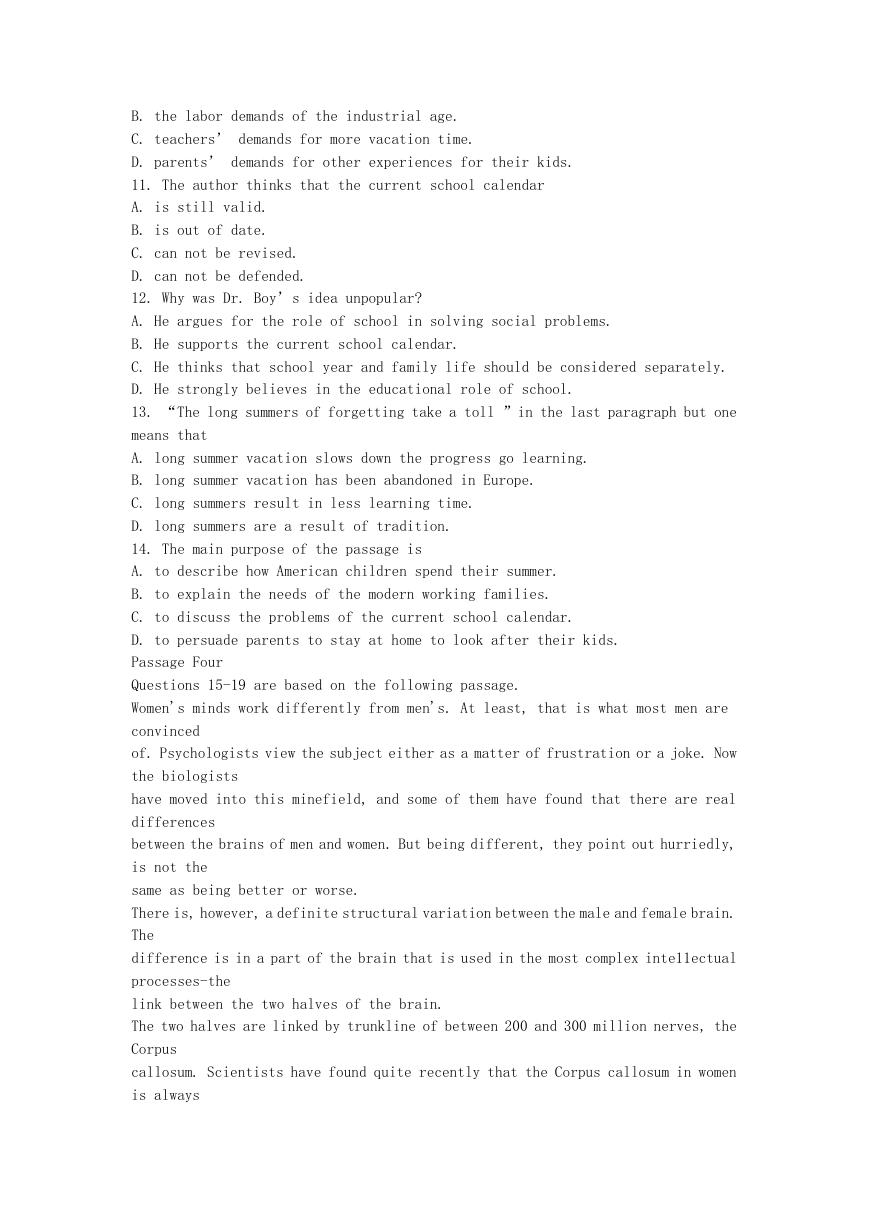
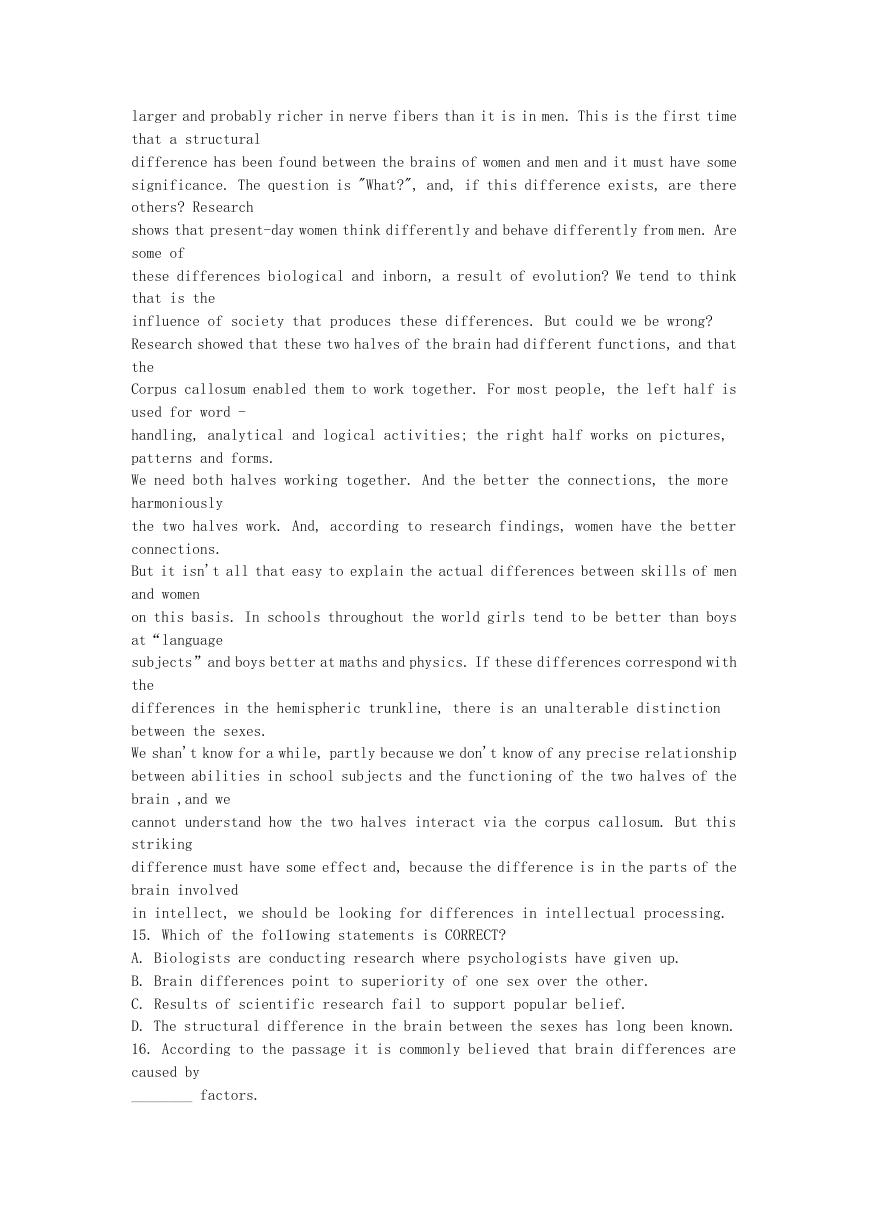

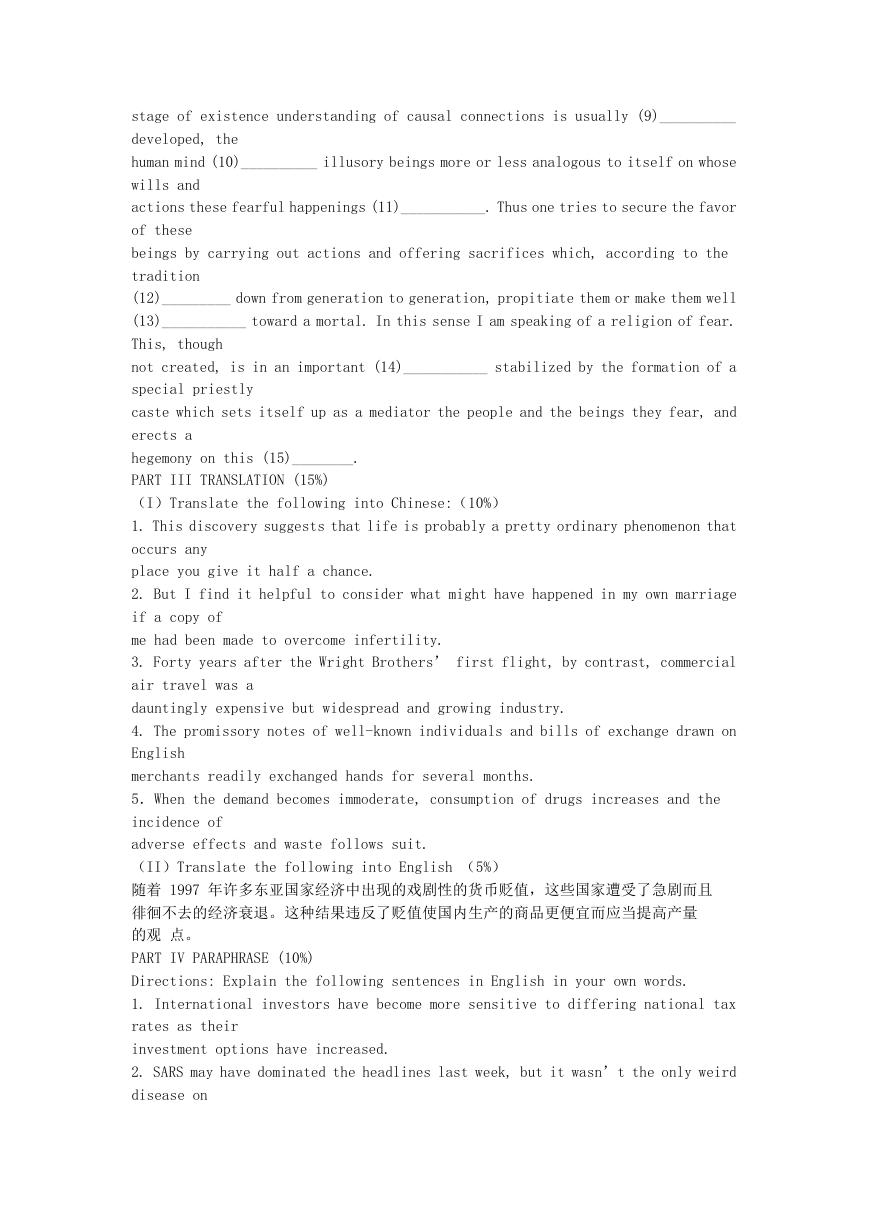








 2023年江西萍乡中考道德与法治真题及答案.doc
2023年江西萍乡中考道德与法治真题及答案.doc 2012年重庆南川中考生物真题及答案.doc
2012年重庆南川中考生物真题及答案.doc 2013年江西师范大学地理学综合及文艺理论基础考研真题.doc
2013年江西师范大学地理学综合及文艺理论基础考研真题.doc 2020年四川甘孜小升初语文真题及答案I卷.doc
2020年四川甘孜小升初语文真题及答案I卷.doc 2020年注册岩土工程师专业基础考试真题及答案.doc
2020年注册岩土工程师专业基础考试真题及答案.doc 2023-2024学年福建省厦门市九年级上学期数学月考试题及答案.doc
2023-2024学年福建省厦门市九年级上学期数学月考试题及答案.doc 2021-2022学年辽宁省沈阳市大东区九年级上学期语文期末试题及答案.doc
2021-2022学年辽宁省沈阳市大东区九年级上学期语文期末试题及答案.doc 2022-2023学年北京东城区初三第一学期物理期末试卷及答案.doc
2022-2023学年北京东城区初三第一学期物理期末试卷及答案.doc 2018上半年江西教师资格初中地理学科知识与教学能力真题及答案.doc
2018上半年江西教师资格初中地理学科知识与教学能力真题及答案.doc 2012年河北国家公务员申论考试真题及答案-省级.doc
2012年河北国家公务员申论考试真题及答案-省级.doc 2020-2021学年江苏省扬州市江都区邵樊片九年级上学期数学第一次质量检测试题及答案.doc
2020-2021学年江苏省扬州市江都区邵樊片九年级上学期数学第一次质量检测试题及答案.doc 2022下半年黑龙江教师资格证中学综合素质真题及答案.doc
2022下半年黑龙江教师资格证中学综合素质真题及答案.doc